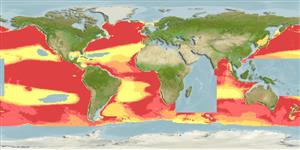Common names from other countries
>
Gadiformes (Cods) >
Macrouridae (Grenadiers or rattails)
Etymology: Coryphaenoides: Greek, koryphaina = dolphin fish + Suffix oides = similar to (Ref. 45335); armatus: From 'cyklos' meaning circle and 'lepis' meaning scale (Ref. 6885).
Environment: milieu / climate zone / depth range / distribution range
Οικολογία
Θαλασσινό(ά) βαθυπελαγικό(ς); εύρος βάθους 282 - 5180 m (Ref. 50610). Deep-water; 65°N - 61°S, 180°W - 180°E (Ref. 1371)
Worldwide: marginal to the Southern Ocean (Ref. 5171).
Μέγεθος / Βάρος / Age
Maturity: Lm ? range ? - ? cm
Max length : 102 cm TL αρσενικό/απροσδιόριστο; (Ref. 1371)
Ραχιαίες άκανθες (συνολικά) : 2; Μαλακές ραχιαίες ακτίνες (συνολικά) : 123 - 124; Εδρικές άκανθες: 0; Μαλακές εδρικές ακτίνες: 115. The head is large; the eyes also large. The snout is elongated, somewhat conical; the mouth is small and inferior. The body tapers from behind the first dorsal fin. The light organ extends past midway between the anal origin and the ventral insertion. Color is uniformly brownish, except for the abdomen which is bluish.
A deep-slope upper continental rise species, common in deep waters of most oceans (Ref. 1371). Bathypelagic (Ref. 58426). Feeds on a variety of benthic invertebrates (especially crustaceans and holothuroids) when young, switching to primarily mesopelagic and bathypelagic fish, and sea urchins and cephalopods as adults (Ref. 1371). Sex ratio was 2.6:1 male to female (n = 449) in the Rockall Tough, N.E. Atlantic (Ref. 40742).
Life cycle and mating behavior
Maturities | Αναπαραγωγή | Spawnings | Egg(s) | Fecundities | Προνύμφες
Cohen, D.M., T. Inada, T. Iwamoto and N. Scialabba, 1990. FAO species catalogue. Vol. 10. Gadiform fishes of the world (Order Gadiformes). An annotated and illustrated catalogue of cods, hakes, grenadiers and other gadiform fishes known to date. FAO Fish. Synop. 125(10). Rome: FAO. 442 p. (Ref. 1371)
IUCN Red List Status (Ref. 130435)
CITES (Ref. 128078)
Not Evaluated
Threat to humans
Harmless
Human uses
αλιεία: χωρίς ενδιαφέρον
Εργαλεία
Special reports
Download XML
Διαδικτυακές πηγές
Estimates based on models
Preferred temperature (Ref.
115969): 1.9 - 5.1, mean 3.3 (based on 3307 cells).
Phylogenetic diversity index (Ref.
82804): PD
50 = 0.5000 [Uniqueness, from 0.5 = low to 2.0 = high].
Bayesian length-weight: a=0.00219 (0.00111 - 0.00431), b=3.20 (3.03 - 3.37), in cm Total Length, based on LWR estimates for this (Sub)family-body shape (Ref.
93245).
Τροφικό Επίπεδο (Ref.
69278): 3.6 ±0.52 se; based on food items.
Ελαστικότητα (Ref.
120179): Πολύ χαμηλό, ελάχιστος χρόνος για διπλασιασμό πληθυσμού > 14 έτη (Preliminary K or Fecundity.).
Fishing Vulnerability (Ref.
59153): High vulnerability (61 of 100).
